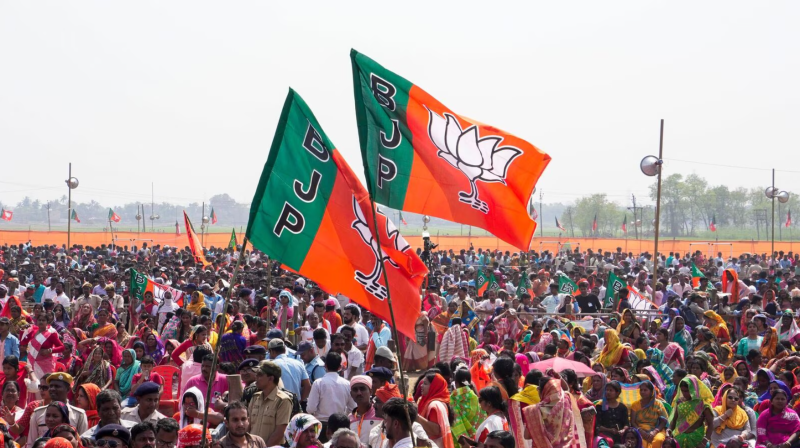
Nearly a billion people are eligible to vote in India’s upcoming elections. Of the 969 million that make up the electorate, about 470 million are women. The South Asian nation is the world’s largest democracy, and to no one’s surprise, its elections are a logistical exercise with no parallel in scale.
The elections are a six-week multiphase marathon, set to begin on April 19. The last stage of voting closes on June 1, with results to follow on June 4. Voting will take place over seven phases, with the election stretched over 44 days to supposedly facilitate polling security and integrity. Analysts have suggested that the longer election provides an opportunity however to the ruling party to manipulate and rig the results, using the infrastructure and agencies of the state to intercede on their behalf.
India is a parliamentary democracy, and the electorate will cast votes to elect 543 members to the lower house of parliament, the Lok Sabha. The party or coalition that secures a majority in the Lok Sabha is eligible to elect a Prime Minister. The voter turnout in India is usually high, with the 2019 polls having drawn a 67% turnout.
There are 2,660 registered political parties in India, and close to a million polling stations will be set up, equipped with nearly 5.5 million electronic voting machines and manned by nearly 15 million election employees and officials.
India also spends more than any other country on its elections, with spending by parties and candidates in 2024 expected to ring in at over $14 billion, likely edging out the spending on the US presidential and congressional election in 2020.
In 2019, the ruling BJP (Bharatiya Janata Party) secured 303 seats, and managed to wrangle a coalition that held 353 out of 543 seats in the Lok Sabha.
There are indications that the BJP, which rules over 12 of India’s 28 states, will cruise to a third straight term in power. BJP Prime Minister Narendra Modi has claimed that his party is eyeing 370 seats in these polls, with their NDA (National Democratic Alliance) coalition’s tally to cross 400. The main opposition party, the Indian National Congress leads a coalition called INDIA, a backronym for Indian National Developmental Inclusive Alliance. The Congress managed to win 52 seats in 2019, with their coalition’s final count at 91.
The decade long rule of Narendra Modi’s BJP has been deeply transformative for India. Not only has Modi entrenched his party in the machinery of the state, but he has managed to project himself as a champion of the common man and a harbinger of development. The BJP government’s domestic policy has revolved largely around revamping India’s infrastructure and providing basic facilities like sanitation and clean water to its gargantuan population.
Modi’s designs to transform India into a major global power have also coincided with a deliberate program to transform the secular Indian state into a Hindu-dominated society. Given the immense diversity among India’s population, the BJP’s Hindutva agenda has exacerbated religious and communal tensions all over the country.
To their dismay, the opposition has struggled to offer a compelling alternative to the Indian voter. The BJP’s Hindu-first ideological program has garnered wide appeal, and its welfare and developmental policies have endeared it to a wider range of constituencies.
The BJP has also made no secret of its plans to use its power as the incumbent government to tilt the playing field in their favor. On March 22, the Chief Minister of Delhi, the Aam Aadmi Party’s Arvind Kejriwal was arrested by the national financial crime investigation agency over corruption allegations. The Congress has recently complained of its bank accounts being frozen, crippling its ability to campaign nationwide. Earlier in the year, Hemant Soren, the chief minister of Jharkhand, was arrested only hours after stepping down from his role, over corruption allegations.
Rahul Gandhi, leader of the embattled Congress, has called the BJP’s tactics “a scared dictator” trying to “create a dead democracy.” Since Modi came to power, over 95% of the cases taken up by the Central Bureau of Investigation (CBI) and the Enforcement Directorate (ED) have been against members of opposition parties, demonstrating a clear pattern of using law enforcement and investigative agencies to target, harass and silence any opposition to the BJP.
The Indian judiciary is widely seen as partisan, and is accused of dragging its feet and doing little to protect political liberties and citizens’ fundamental rights.
While using the agencies of the state to target opposition parties, Modi’s BJP government also introduced electoral bonds, a controversial anonymous election finance instrument that the Supreme Court struck down as unconstitutional in February, in a rare display of defiance against the ruling party. The Supreme Court’s disclosures revealed that Modi’s BJP has been the beneficiary of more than half of all corporate donations since 2018, valued at around $700 million.
This unmarked, anonymous funding mechanism has allowed the BJP to fashion a dominant electoral machinery, with civil society groups and rival parties labelling the bonds a mechanism for legalized, institutionalized corruption.
The BJP has also resorted to deliberately playing up communal tensions as a strategy to improve its electoral chances. The government put the controversial Citizenship Amendment Act (CAA) into effect earlier in March, a law that experts claim will be used to legitimize discrimination on the basis of religion and deny citizenship to Muslims.
Modi also inaugurated the divisive Ram Mandir in February, a temple built on the site of the Babri Masjid in Ayodhya. The mosque was demolished in 1992 by right-wing religious zealots from the RSS (Rashtriya Swayamsevak Sangh), the BJP’s ideological lodestar and its organizational parent. Modi’s party turned the consecration of the Ram Mandir into an electoral rallying cry – with chants of “mandir wahein banega” (the Temple shall be constructed there [the site of the Babri Mosque]) echoing at the ruling party’s election rallies for over two decades.
The harassment and targeting of opposition parties by the Modi government, coupled with the BJP’s astute navigation of India’s caste and religious equations, has all but ensured that the ruling party will secure a third consecutive term in office. With the BJP’s Hindu nationalist brand of politics on full display and India globally ascendant as an independent and assertive power, India’s 2024 election is set to be a referendum on India’s future as a secular parliamentary democracy. All signs point to the world’s largest democracy being slowly but surely transformed into a Hindu ethno-religious majoritarian state.
